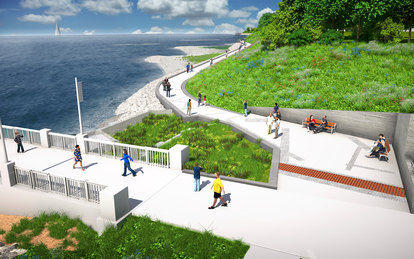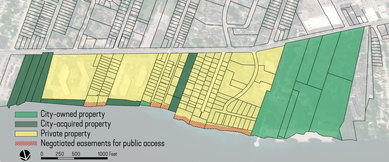欧几里得市水滨改造

In theory, the project seemed straightforward. A city on a large body of water wanted to provide public access to the shoreline via a trail. That trail would connect two parks and would be roughly a mile long. How difficult could it be?
But the complications that popped up on this project would have made most communities throw in the towel early. The City of Euclid, an eastern suburb of Cleveland, Ohio with about five miles of shoreline on Lake Erie, is an inner-ring suburb that grew quickly during the post-World War II national suburbanization buildout. In the mid-2000s, the city decided it was time to take better advantage of its lakefront. Approximately 95% of the lakefront property in the city was privately owned, and the city believed that it would be both socially and economically beneficial to expand public access to the shoreline.
But there were many hoops to jump through in order to make that vision a reality. The U.S. Fish and Wildlife Service and the U.S. Army Corps of Engineers had standards and perspectives that would have to be met. The Ohio Environmental Protection Agency and Department of Natural Resources would be reviewing the project to make sure it met their guidance and protected environmental resources, and the Governor of the State needed to sign an authorization allowing public waters to be used for planned shoreline improvements. And neighboring cities, counties and other state agencies would have their say as well.
There was also the cost. Initial phases of the effort were projected to cost $7 million, and for a suburb going through economic challenges due to housing-value decline and the loss of manufacturing jobs, the selling points did not play well with some groups in the city.
And if all those issues seemed difficult, the greatest challenge was going to be getting all the private landowners to agree to it. Great Lakes states operate under various forms of “riparian law,” which means that a landowner owns the property up to the water line itself. No eminent domain or other forced transfer of property can be used. In other words, public access to any part of a landowner’s property along the lakefront without their consent is prohibited by law.
After considering the many complexities associated with this project, SmithGroup, along with the City Council and planning department, engaged the community and recognized a potential solution. The residential property owners—some single-family, some large apartment complexes—were experiencing long-term, ongoing erosion problems with the bluffs above the lake. It was costing the owners approximately $1,000 a linear foot to shore up those cliffs every decade.
The city proposed the following solution: If the property owners would give the City permission to build a public access trail at the bottom of their bluffs and grant an easement to their ownership, the City, in return, would stabilize the shoreline as the trail was built, saving the property owners the ongoing costs of repairing and maintaining the bluff themselves.
While it required five years of meetings and negotiations, all of the property owners agreed to this proposal for mutual benefit. From SmithGroup’s and the City’s perspective, the scale of this unique partnership with such a large number of individual property owners is different than anything we’ve worked on in the past, and provides a replicable model for fusing coastal resilience with environmental restoration and public access on the Great Lakes. (Read more about the many unique facets of this project in Dan McGraw’s article, Did a Hundred Homeowners Just Change the Great Lakes Forever, featured in NextCity.org.)
The public supported this plan, and also agreed to fund the building of public pathways and boardwalks interwoven with innovative shoreline protection, small beaches, wildlife habitats and recreational enhancements along Lake Erie. To date, the City with assistance from SmithGroup has been able to secure over $5.5 million in County, State and Federal funding for the initial shoreline improvements and was awarded nearly $2.6 million toward future shoreline phases.
“Euclid is a city with challenges,” said Euclid Mayor Kirsten Holzheimer Gail. “We can’t just focus on all things immediate but instead have to invest in long-term growth and stability that puts Euclid on a different trajectory. Our belief is that connecting Euclid more accessibly to Lake Erie does just that.”
Matt Doss, policy director for the Great Lakes Commission, thinks that what is happening in Euclid is reflective of a larger shift in the way we view public waterfronts. “What you are seeing in Euclid is the change in the structural attitude toward dealing with the Great Lakes access issue, and it is an example of landowners working with government, which has been something hard to overcome.”
Click here to learn more about SmithGroup’s work with the City of Euclid.

